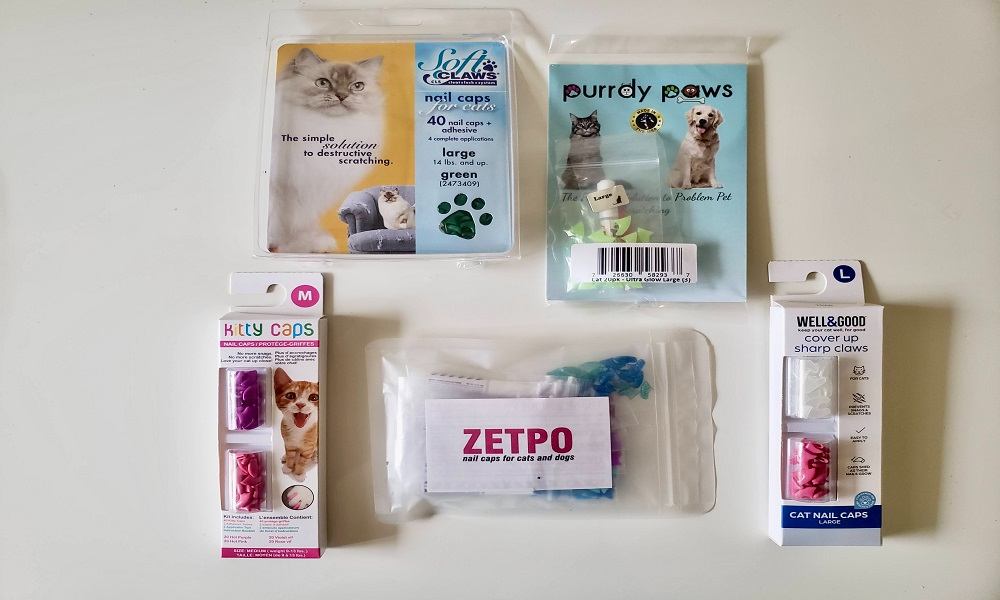
Liz Coleman / Cats.com
After researching the market, poring over product roundups, studying customer feedback, and testing five well-regarded nail cap brands, I’ve chosen the Soft Claws Cleat Lock System as the best choice for most cats.
Longevity and ease of application were two major factors that made Soft Claws the obvious pick for me. They were pretty easy to apply—even for a first-timer—and they stayed put for the longest amount of time. Compared with the other tested brands, Soft Claws caps are made with a slightly thicker plastic, lending them the right blend of comfort and durability. And they were affordable, to boot.
Soft Claws offers a variety of colors, and they’re widely available at many pet retailers.
At a Glance: Our Top Picks for Best Nail and Claw Caps for Cats




Want a quick look at the products reviewed in this article? In the comparison table below, we’ve highlighted some of the most important features of each product. You’ll find more detailed information about each product later in the article.
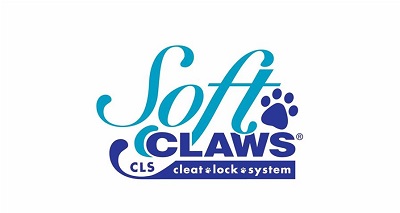
Soft Claws Cleat Lock System
- Thick, durable material
- Flexible
- Easy-to-squeeze glue tube

Well & Good Nail Caps
- Most durable material
- Clear caps make it easy to fill with glue

Purdy Paws Soft Cat Nail Caps
- Easy to apply & comfortable to wear
- Available in glow-in-the-dark
- Available in 5 sizes, including kitten

Zepto Cat Claw Covers
- Best value
- Large variety of colors
- Kitten size available

Kitty Caps Cat Nail Caps
- Good value
- Long-lasting
- Can be used on kittens 12 weeks old
Why Should You Trust Us?
Because we’re crazy cat people, just like you. We only want the best for our pets, which is why we’ve personally tested (with varying degrees of success) hundreds of cat toys, foods, and accessories.
Our cat-obsessed team leaves no stone unturned, and we examine each product on several fronts, looking at efficacy, the practicality of use, safety, and affordability. Then we pass those findings on to you, recommending only the items we’d use with our own cats.
To familiarize myself with the top nail cap brands (and which cats will suit them best), I took a deep dive into the reviews of real cat owners. I also consulted with a few veterinarians and cat behaviorists to verify the safety of nail caps. This helped me narrow down my pool of potentials to five products for testing on my own cat, Floyd.
What Features To Look For in Cat Nail Caps
If you’re new to cat nail caps, the abundance of options can be overwhelming. Here are some key considerations when shopping.
1. Size
Nail caps are sold in different sizes, which typically correspond to a cat’s weight. Cap sizes are not universal among brands, however, so it’s important to check individual size charts before purchasing. Getting the wrong size can result in an uncomfortable fit, and may even hurt your cat.
2. Material
Most nail caps are made with a cat-safe vinyl resin (including the five caps we tested). This material feels like a soft, pliable plastic that can be manipulated to fill the caps with glue.
“Many nail caps are made from non-toxic materials, and the glue used to apply them is inert once dry,” confirms Janet Cutler, Ph.D. a certified cat behaviorist at Cat World who has used nail caps on her own cat. Even so, Cutler recommends checking the materials used by any brands you’re considering to ensure they’re safe. This becomes especially critical if your cat happens to swallow one.
3. Number Of Caps Included
Nail cap kits come in an assortment of quantities—from single sets of 20 to economy packages with over 100. Beginners might want to stick with a smaller kit to see how their pet tolerates the caps first (although, having a few extra caps handy is nice if you accidentally over-fill them or lose any).
Consider, too, how frequently you want to purchase caps, and whether you’ll be using them on just the front paws or your cat’s back paws as well. Finally, how many cats will you be outfitting with caps? A set of 20-40 caps will only go so far in a multi-cat household.
4. Color
I’ll preface this with a quick caveat: while undeniably cute, nail caps should not be used as a fashion accessory. They’re designed for practical purposes (more on that below)—so if your interest in nail caps stems from a desire for matching mani-pedis, nail caps probably aren’t for you.
For cats who can benefit from nail caps, you have your pick of colors: caps are sold in vibrant neons, glitter colors, and even glow-in-the-dark designs. For cats (or humans) with a more reserved style, there are clear nail caps as well.
Clear caps make sense if you’d rather not call attention to your kitty’s paws; however, they can be harder to spot if one falls off. I also found that it was easier to see the glue as I was filling the clear caps, unlike the solid-colored ones (a few of which I had to discard after inadvertently overfilling with glue).
Why Would Cat Parents Use Nail Caps for Their Pets?
Nail caps are not just for looks. Here are four practical reasons cat parents might try using nail caps on their pets.
1. To Protect Surfaces From Destructive Scratching
Scratching is a natural feline behavior. Cats scratch to mark their territory, stretch their limbs, and remove the dead, outer layer of their nails. But if your cat forgoes their scratching post in favor of your sofa or curtains, nail caps can help. (Personally, I was hoping to spare some of my nicer sweaters.)
Speaking of natural cat behaviors, Dr. Cutler assures us that properly applied nail caps shouldn’t affect your cat’s mobility. “The covers go over the exposed part of the nail, and the tendons that extend the claws should not be affected,” she says. Your cat can still stretch, scratch, and detract their claws—just minus the destruction.
2. To Protect Vulnerable Human Skin
Maybe you have a new baby at home, or a toddler who has yet to learn how we play with kitties. For older folks with delicate skin (and potentially slower reflexes) as well as people with autoimmune diseases, a seemingly simple cat scratch can become a serious problem. Using nail caps is a humane way to keep everyone at home safe.
3. To Protect Cats Who Scratch Themselves Due To Anxiety
If your cat is flea-free and doesn’t suffer from allergies, their constant scratching could be anxiety-related. In these cases, nail caps can be used to prevent self-inflicted wounds.
4. To Protect Hairless Cats Or Cats With Sensitive Skin
With no barrier between sharp claws and their skin, hairless cats like the Devon Rex or Sphynx make good candidates for nail caps. And caps can also shield the skin of cats with allergies who suffer from chronic itching.
Alternatively, Who Might Want To Pass on Nail Caps?
Nail caps won’t work for every cat. Outdoor cats, for one, would be rendered defenseless with caps on their claws, Cutler points out. “Cats that go outside typically need their sharp nails for climbing and protection, so this is not a good option if your cat has outdoor access.”
Cat parents should also consider their own willingness (or ability) to add another grooming task to their agenda. “Nail caps require some maintenance, with most brands recommending nail trimming and replacement every 4-6 weeks if they have not fallen off on their own,” Cutler tells us. So if you’re unable to trim your cat’s nails or reapply caps routinely, then perhaps nail caps aren’t the answer.
Lastly, there are some sensitive cats who just won’t acclimate to nail caps, even after allowing for a period of adjustment. “Most cats may initially lick and bite at the caps but quickly lose interest and can be distracted with treats and play,” Cutler explains. “If your cat continues to be bothered by them after wearing them, then you may want to consider an alternative option.”
After researching nail caps and reading customer reviews, I chose the following 5 for paws-on testing.
Based on advice from veterinary experts and feedback gathered from pet parent reviews, I established a few parameters for what makes a good nail cap. The selections featured here were chosen for hands-on testing because:
- They are made with safe, non-toxic materials
- They’re made by reputable, trustworthy brands in the pet space
- They’ve received a lot of positive reviews from real cat parents
- They included everything you need to apply them at home (adhesive, applicators, instructions, etc)
The 5 nail cap kits I tested were:
- Soft Claws: Cleat Lock System
- Purdy Paws Soft Cat Nail Caps
- Kitty Caps Nail Caps
- Well and Good Nail Caps
- Zepto Cat Claw Covers
After Receiving the Caps, I Subjected Them to a Series of Tests.
Test #1: Ease Of Application
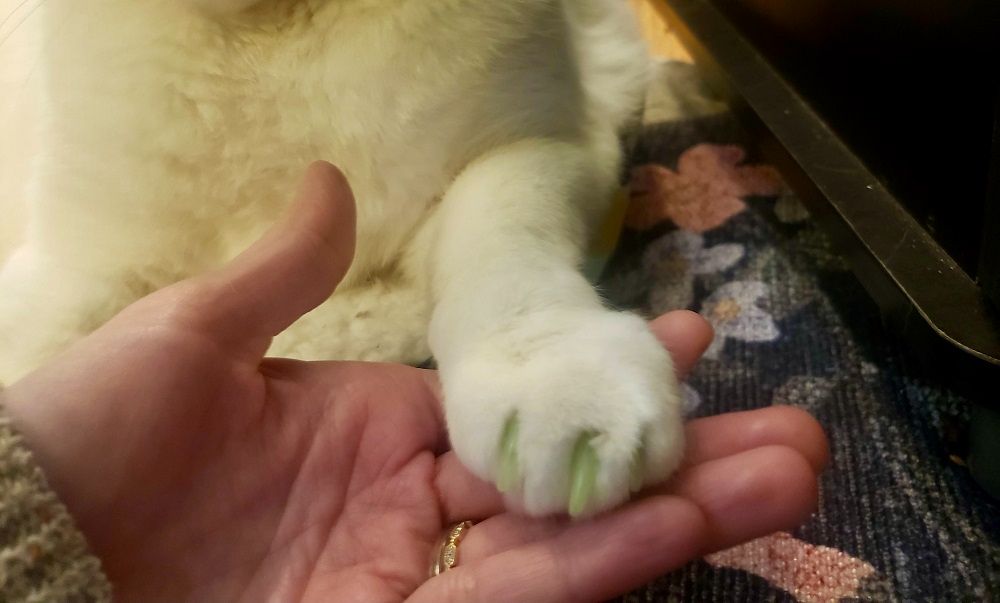
I applied the nail covers to my cat’s claws, taking notes on how easy each was to put on. Liz Coleman / Cats.com
If the prospect of applying tiny plastic covers to a displeased cat’s sharp claws seems daunting, you’re in good company. To keep stress to a minimum, I was looking for nail caps that were quick and (relatively) painless to apply.
For me, this meant easy-to-squeeze glue bottles and pliable caps I could manipulate with my fingertips. I found Soft Claws and Purdy Paws had a flexible, rubbery feel that made it easy to coat them evenly with adhesive. Along with the Zepto caps, they also came with glue tubes that dispensed product with minimal effort. The Well & Good and Kitty Caps, on the other hand, had more stubborn glue tubes that required a firmer squeeze to dispense.
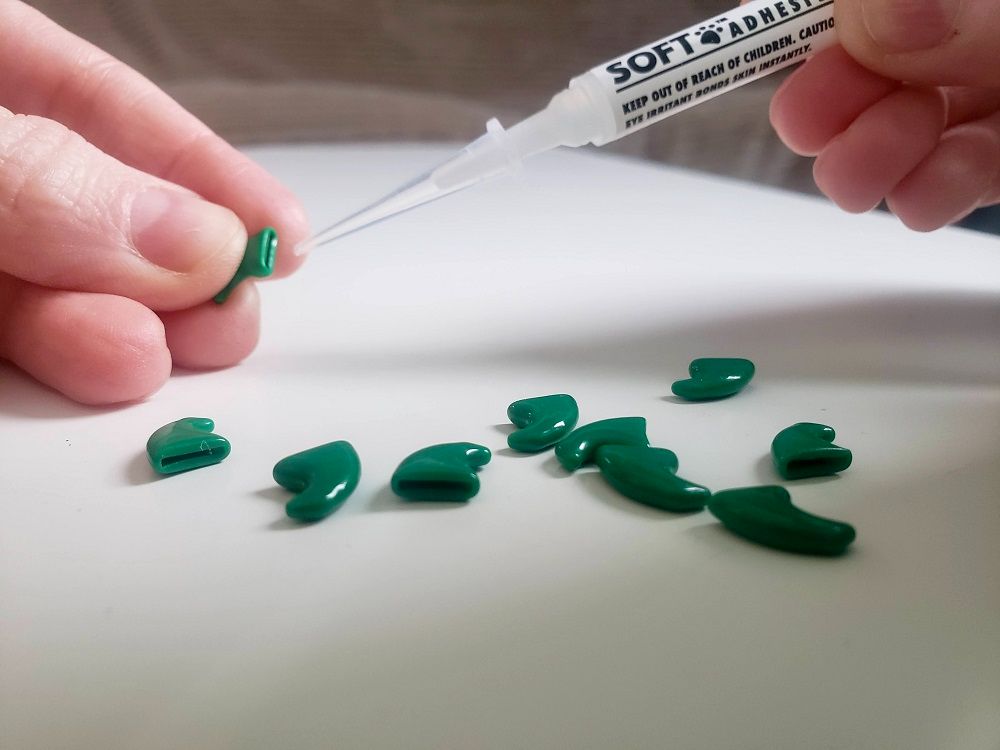
I looked at how easy it was to squeeze the glue into each of the caps. Most were easy to dispense, but a couple of them had firm tubes that were difficult to squeeze. Liz Coleman / Cats.com
I think it’s worth pointing out that there’s an element of familiarity and practice that comes into play—the first time you apply nail caps, it might be a little tricky! To simplify the process, it’s helpful to get everything ready beforehand, take your time, and give your cat intermittent breaks if necessary. By the time Floyd’s nails were ready for a second round, I was more confident with the process.
Test #2: Cat Comfort Test
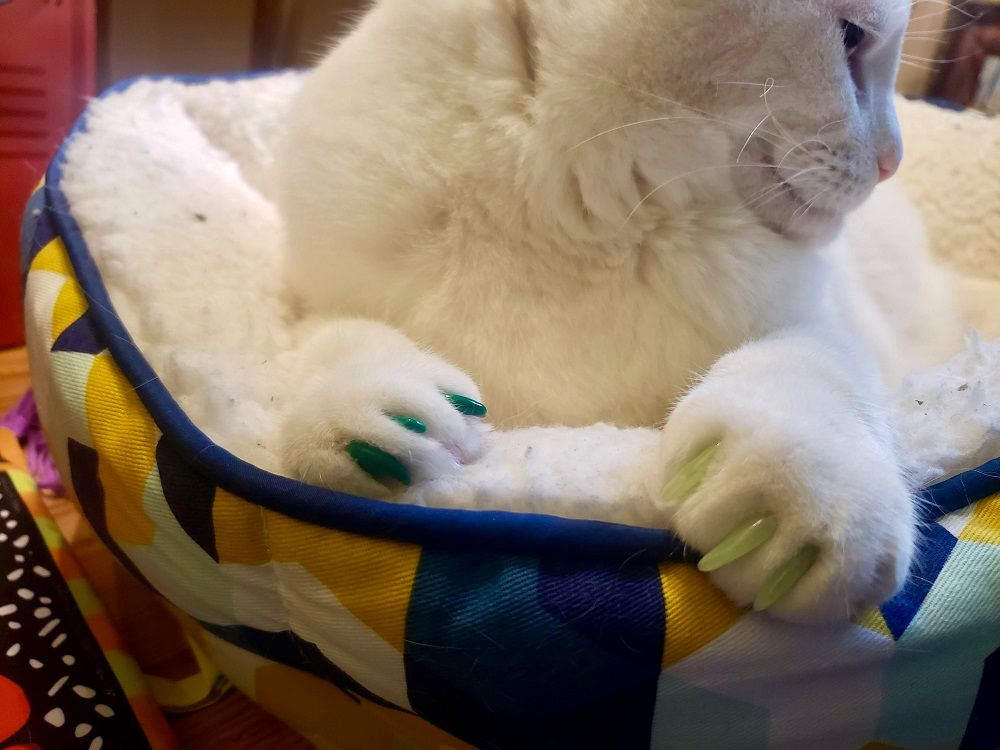
As you can see, Floyd tried out two brands of nail caps at once. For the most part, he was comfortable with all of them once they were set on his nails. Liz Coleman / Cats.com
Next, I observed how well Floyd tolerated the nail caps. I wanted to know if the caps would bother him in any way, or if they would affect his gait or behavior.
For every brand we tried, Floyd had the same basic reaction: at first, he fussed. Then he seemed to forget the caps were even there. There was some mild protesting during the application process, although I think Floyd was more offended about having his paws handled than the nail caps, themselves.
As for his mobility, I didn’t notice any changes. He could still walk, jump, stretch, and carry on as usual. For the most part, Floyd seemed unphased by these tiny plastic covers. Although, I’d occasionally catch him yanking at them with his teeth.
Test #3: The Fabric Test
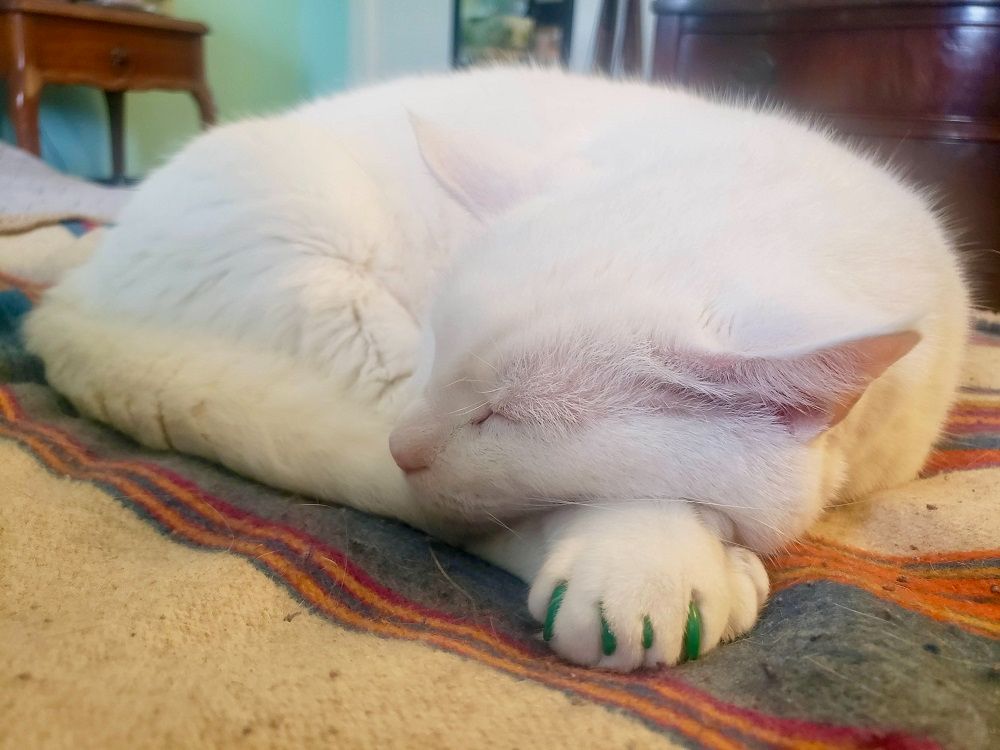
I observed how the nail caps kept Floyd’s claws from snagging soft surfaces around the home. Liz Coleman / Cats.com
Finally, I wanted to learn if nail caps actually do what they’re supposed to do (ie: protect skin & fabric.)
Since I’m fortunate to share my home with two cats who keep their scratching to (mostly) appropriate surfaces, I couldn’t track the caps’ effectiveness at protecting things like furniture. Instead, I watched how Floyd’s kitty bed fared with a round of enthusiastic kneading.
For this test, I applied nail caps to one of his paws, leaving the second paw cap-free. As it turns out, the caps still got caught on the bed’s sherpa lining. But I can see how the blunted tips would make considerably less damage than a sharp, uncovered claw.
Best Cat Nail Caps: Our Top 5 Picks Reviewed
Are Nail Caps a Good Solution for Your Cat?
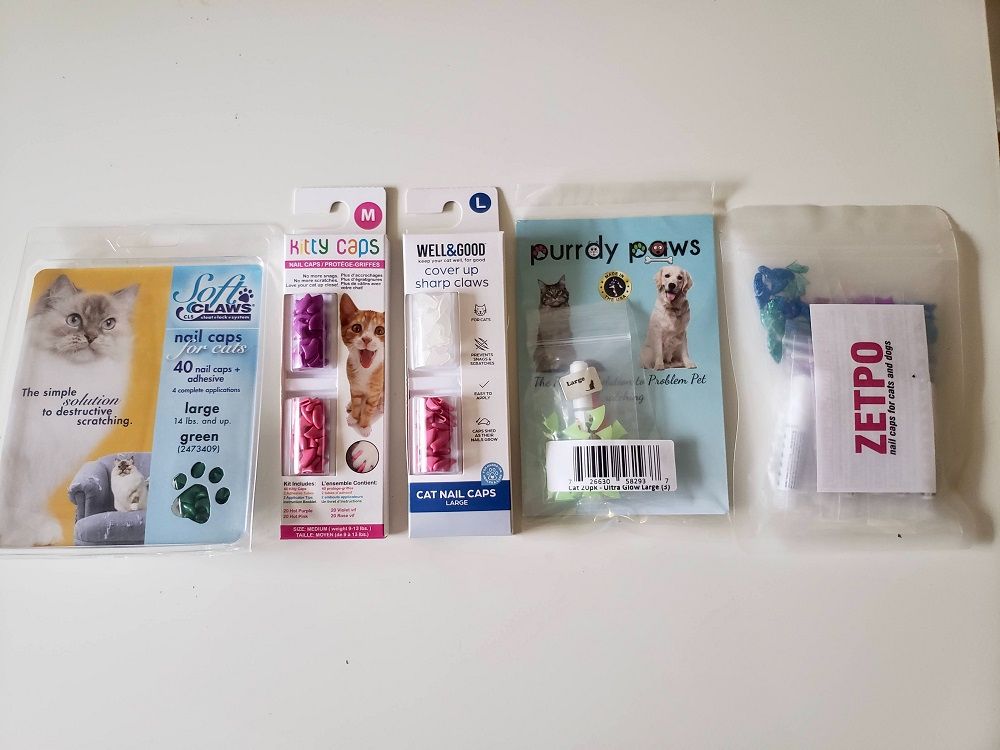
Liz Coleman / Cats.com
Overall, I think nail caps will be a practical solution for many cat parents. That said, individual success will depend on how well your own cat handles the application process, and whether or not you’re able to keep up with nail maintenance.
It’s helpful to have realistic expectations of how the application process will go. Despite the insistence of retailer sites that nail caps are an effortless breeze to apply, I wouldn’t call the experience a “piece of cake.” There is absolutely a learning curve here—and if your cat is resistant to wearing nail caps, the process could turn out to be doubly challenging.
Some tips for easing into the process:
- Consider applying when your cat is drowsy (my personal tactic)
- Use positive reinforcement and distractions like food, treats, toys, and praise
- Trim your cat’s nails beforehand for a proper fit
- To make sure the fit is correct, slide the cap onto the nail without glue, first
- Don’t overfill the caps with glue: and be careful about getting it on fur or skin (it’s super sticky!)
- Monitor your cat’s behavior and comfort level during the adjustment period
Keep in mind that some cats just won’t take to nail caps, and in these cases, it’s best to consult your vet for alternative solutions. While nail caps can be helpful, they don’t address the underlying reason behind your cat’s destructive scratching, so they may benefit from a behavioral consultation to get to the bottom of things.
And finally, if you find applying the caps too challenging for you to do at home, many groomers and veterinarians will happily apply them for you.
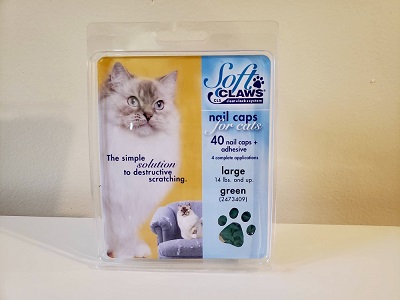
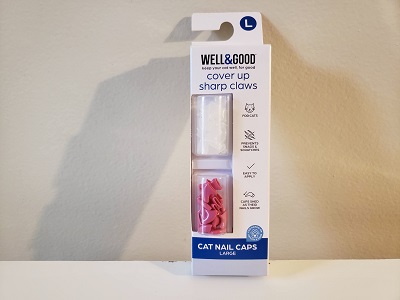
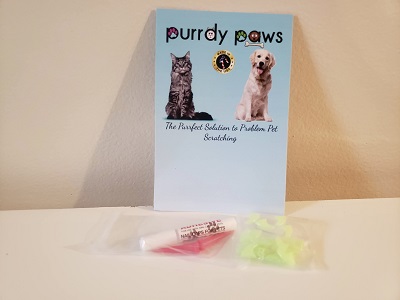
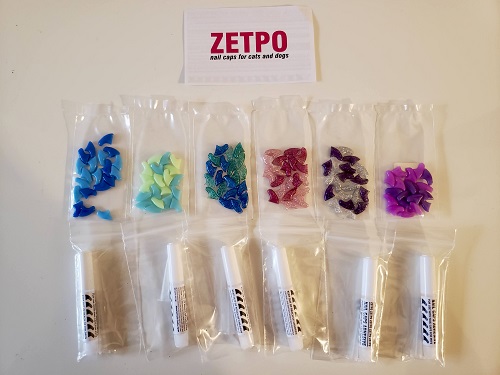
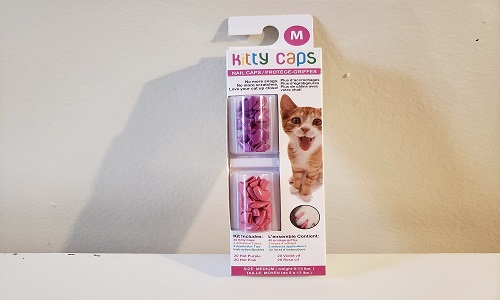
Are you crazy! They could swallow these!
I didnt get that… “beaten” must have been a typo. What happens often if the cat is active, does it fall off from the glue a lot?
I only ordered 20 for $17.
Hey Priscilla! You’re right to be confused—I’m having trouble understanding this article, myself. It’s one of our older pieces and wasn’t properly proofread. Frankly, I think that claim was inaccurate as well; active cats can wear nail caps just as well as inactive cats, and they usually won’t come off unless the cat is really fighting with them, biting and pawing at the caps. I’m looking into getting this piece updated so it’ll be a bit more accurate and easy to understand. Thank you!